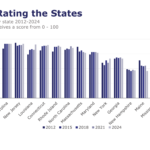When it comes to sales and marketing, carriers that distribute through independent agencies are not in control.
Executive Summary
Sharing critical sales and marketing analytics can change the game for carriers and independent agents, according to Jason Walker, the co-founder of a company that provides digital technology solutions for agents. Walker lists three potential areas of collaboration between a carrier and its agency distribution force that he believes every carrier should consider. He describes the benefits of obtaining analytics from independent agency partners, barriers to be overcome, types of information available in today’s digital market and explains how carriers can ensure their agency partners are gathering and saving the right information.Many carriers have put significant focus on data and analytics within their own organizations, from predicting claims to developing rates. Far fewer carriers have focused on the front end and using analytics to better understand target markets and customer behaviors. This is especially true for carriers that distribute through independent agencies where they often don’t have direct access to key information.
The insurance market is changing and is continuing to become significantly more competitive for both carriers and agencies. Having a deeper understanding of target market behaviors, web preferences, and specific product interests through the use of digital metrics can be critical to competing more effectively with direct writers and Insurtech apps that have the ability to analyze and predict consumer behaviors through the channel end to end.
Carriers and agencies that can not only capture but also share and act on this type of data and analysis can gain a significant competitive edge, fostering their ability to identify which products to promote in what markets, expose cross-sell and up-sell opportunities, forecast with more accuracy, and better understand overall customer purchasing behavior. Unfortunately, the majority of carriers do not have access to this information for two key reasons: many agencies don’t have the technology to collect it and others don’t have the motivation to share it.
To succeed in a highly competitive market, carriers need to partner with their agencies to ensure they are adopting the right technologies to make a difference and to foster and grow relationships that promote transparency and sharing.

Website pageviews, asset downloads, event attendance, social media interactions and submissions of “contact” us or “request a quote” forms are all essentially virtual hand raises that can be used to identify customers’ purchasing intent.
For example, wouldn’t a carrier that targets retail BOP be interested to know how many customers view the agency’s webpage or download whitepapers on business insurance? And what if the data could further show the carrier that 85 percent of the companies that downloaded that information were small electronics stores?
Having this level of data can help carriers identify how to further their portfolios of products, as well as the right tactics and technologies to ensure agencies and customers are supported with efficient processes.
In addition, access to data improves marketing by enabling carriers to advertise the right risk solution for a customer based on highly targeted campaigns (which have a much higher conversion rate than top-of-the-funnel awareness campaigns). But how can carriers begin acquiring these types of analytics?
There are three areas every company should consider in collaborating with its agency distribution force.
1. Let’s talk tech
 Collecting the right data all starts with having the right technology. For insurance carriers and agents, technology is at the heart of the insurance consumer buying cycle. Prospects visit an agency’s website to obtain online quotes. Customers can log into a portal to view policies and make changes. Agents use customer relationship management (CRM) systems to manage a relationship throughout the sales pipeline.
Collecting the right data all starts with having the right technology. For insurance carriers and agents, technology is at the heart of the insurance consumer buying cycle. Prospects visit an agency’s website to obtain online quotes. Customers can log into a portal to view policies and make changes. Agents use customer relationship management (CRM) systems to manage a relationship throughout the sales pipeline.
For seamless interaction between a carrier and its agencies, both parties should adopt solutions that have the flexibility to integrate front office and back office operations while remaining focused on the customer experience. Infrastructure should combine lead aggregation and distribution with customer relationship management and return-on-investment measurement for all lead sources such as website, paid leads, networking events, webinars, social media, and referrals.
Agencies should provide access to customer portals through a customer-centric web experience that connects with appointed carriers. Carriers and agencies should also invest in tools that disseminate one-to-one and one-to-many communication streams between agents and customers which will empower sales and retention initiatives. By utilizing these technologies, carriers and agencies will be able to account for all marketing, sales and retention campaigns—enabling them to plug and play a variety of tactics to monitor appetite drivers, ideal customer profiles and preferred buying formats.
2. Assist less tech-savvy agencies
Data will not only benefit carriers’ marketing efforts, but also the efforts of independent agencies; however, some agencies might be falling behind in adoption of digital tools that are necessary to gather key information. Carriers should invest in education and best practices programs for their agencies. They should also spearhead training and continuing education courses.
Assisting with digital adoption also reinforces the carrier’s commitment to the independent agency distribution model. Shifting an agency’s operation and mentality toward technology and an always-on customer experience is no small undertaking. A carrier that helps agencies evolve and graduate will be acknowledged as a carrier of choice.
3. Don’t stumble over data sharing hurdles
There are quite a few challenges to acquiring the necessary marketing data from partner agencies. Awareness of these hurdles can help carriers avoid getting stopped in their tracks. Issues can include:
- Customer privacy and ownership of information.
- Cross-pollination and exposure of competing carrier production.
- Data integrity.
- Disparate systems.
- Lack of integration that provides a seamless customer experience and proper handoffs between the agency, carrier, and third-party technologies.
- Lack of information-gathering standards and adherence to those standards.
To avoid these issues, carriers need to develop strong partnerships that are built on trust and transparency with their agencies. Start working with top agents first. A strong foundation already exists, and these agents will be most willing to invest in the relationship. There will also be a large amount of data points to work with, since top agents sell more of the carrier’s products.
One of the keys to effective insurance marketing is good data. Carriers and independent agents should be partnering to obtain information that completely articulates consumer purchasing behaviors. By investing in the right technology and training programs, carriers can ensure that their agencies are equipped to systematically gather insightful analytics. Working together, carriers and agents can market the right solutions to the right customer and surpass their competition.





















 Study: U.S. Companies Facing Class Actions at Highest Level in 13 Years
Study: U.S. Companies Facing Class Actions at Highest Level in 13 Years  IBHS: Virginia Edges Florida Out of First Place in Building Code Adoption
IBHS: Virginia Edges Florida Out of First Place in Building Code Adoption  The Supreme Court Just Complicated Employer Diversity Initiatives
The Supreme Court Just Complicated Employer Diversity Initiatives  Study: Average Cyber Breach Insurance Coverage Gap is 350%
Study: Average Cyber Breach Insurance Coverage Gap is 350% 

